07/12/05 for KeelyNet
This article is the result of recent posts about 'flying men' which made me start thinking about how such a personal flying machine would function, particularly with maneuvering. It is based on the use of a propelling force, where direction is determined by the gyroscopic description in the article.
Recent photos posted to Rense.com, show what appear to be a flying man/humanoid shape or small flying device.

| |||||||||||||||||||||||||||||||
 Image A |
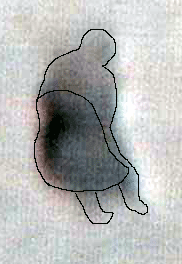 Image B |
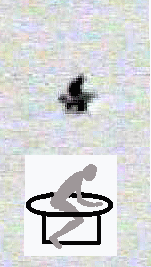 Image C |
-
Image A - a clipped, enlarged image from the Rense site video at the site posted above, no editing done
- Image B - I did a color balance and drew a rough line around the figure to show what could be the outline of a human figure apparently in a chair or seat
- Image C - a clipped, enlarged imaged from another site which shows what appears to be a human figure riding in a flying ring, almost like a babys' rollaround toy
- Image A - a clipped, enlarged image from the Rense site video at the site posted above, no editing done
- Image B - I did a color balance and drew a rough line around the figure to show what could be the outline of a human figure apparently in a chair or seat
- Image C - a clipped, enlarged imaged from another site which shows what appears to be a human figure riding in a flying ring, almost like a babys' rollaround toy
Is this simply a form of Video Rorschach (inkblots described to help determine mental state), reading things into images that simply aren't there? The eyewitnesses say it definitely wasn't a bird, a balloon, swamp gas (in the middle of a city?) or anything they could imagine that could move indendently like that. But its a similar story with UFOs and seeing God, an experiential event, except in this case and many UFO cases, there is sometimes trace evidence in the form of tracks, photos or footage, as well as the viewers reports to consider. Yes, this could be imagination, but there is a possibility it could really be someone doing a 'test drive' of their newfound discovery, based on video footage from more than one sighting, more than one location, different time periods and eyewitness accounts of small, man-shaped flying objects or even people? There is much more to the idea of some kind of new gravity cancelling or other flying technologies than I can possibly inform you about in this article. Those who have read many of the KeelyNet files will see other correlations, not to mention many other news reports about science and alternative science on the web and in other media. All I can do is highlight and correlate, not spell it all out for casual readers who will just snort, laugh and blow it all off as wishful thinking. Those are the people who still think gravity is a pull, when all indications, proven by over 100 experiments, is that gravity is in fact a push. You'll note there is not one single experiment to prove gravity is a pull. It is the same thinking that refuses to comprehend that gravity is a VARIABLE force (like changing light intensity with a light dimmer switch) which can be increased, reduced or even cancelled, by deflecting its flow into a mass. No matter, those of us who study such matters will eventually figure it out and make it widely available for use by everyone.

Transport through air, water or space involves 3 dimensional coordinates, whereas transport over land only uses 2 dimensions. Thus for our purposes of flight through air, we need all 3 axis, X for up and down, Y for left and right, Z for spin.

The Coriolis Force
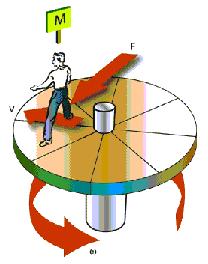 First, we should consider the Coriolis force and how it might apply.
Coriolis Force results from acceleration acting on a mass, and anyone who walks radially outward on a moving merry-go-round experiences the force.
A person must lean toward or direct the mass of his or her moving body against the force that the Coriolis acceleration produces.
If we know the force (F) acting on the body, the velocity (V) of the body, and the angular velocity (?) of the platform, we can calculate the person's mass (M).
First, we should consider the Coriolis force and how it might apply.
Coriolis Force results from acceleration acting on a mass, and anyone who walks radially outward on a moving merry-go-round experiences the force.
A person must lean toward or direct the mass of his or her moving body against the force that the Coriolis acceleration produces.
If we know the force (F) acting on the body, the velocity (V) of the body, and the angular velocity (?) of the platform, we can calculate the person's mass (M).

Precession
Then the gyroscopic effect of Precession.
 The motion of the gyroscope shown here is an example. The silver colored rotor inside the gimbal rings is spinning rapidly about its axis.
As we will see, it is the presence of the little weight, hung on one end of the axis of rotation of the spinning rotor, that causes the observed motion about the vertical axis. Our intuition might suggest that the weighted end of the rotor's axis would move down, not go around.
The motion of the gyroscope is much more complicated, as you might observe in an actual experiment where the rotation of the rotor slows down over time.
We can see that as the rotor slows, the precessional frequency increases. At some point when the precessional frequency exceeds a critical value, the gyroscope will begin to wobble and eventually tumble in its gimbals.
Rigidity in space refers to the principle that a wheel with a heavily weighted rim spun rapidly tends to remain fixed in the plane in which it is spinning.
So an accurate definition of Precession would be:
The motion of the gyroscope shown here is an example. The silver colored rotor inside the gimbal rings is spinning rapidly about its axis.
As we will see, it is the presence of the little weight, hung on one end of the axis of rotation of the spinning rotor, that causes the observed motion about the vertical axis. Our intuition might suggest that the weighted end of the rotor's axis would move down, not go around.
The motion of the gyroscope is much more complicated, as you might observe in an actual experiment where the rotation of the rotor slows down over time.
We can see that as the rotor slows, the precessional frequency increases. At some point when the precessional frequency exceeds a critical value, the gyroscope will begin to wobble and eventually tumble in its gimbals.
Rigidity in space refers to the principle that a wheel with a heavily weighted rim spun rapidly tends to remain fixed in the plane in which it is spinning.
So an accurate definition of Precession would be:
When an outside force tries to tilt a spinning gyro, the gyro responds as if the force had been applied at a point 90 degrees further around in the direction of rotation. This effect is called precession, because the cause precedes the effect by 90 degrees.

Gyroscopes as a means of Free Energy
 To better understand precession and how it might apply to free energy, I repeat the image of the Gyroscope animation in the preceding section for your perusal.
In researching this article, I found an intriguing mention which I recount here, unfortunately, I didn't get the URL for the site, but the following speculation/claim was the only free energy comment on the page;
To better understand precession and how it might apply to free energy, I repeat the image of the Gyroscope animation in the preceding section for your perusal.
In researching this article, I found an intriguing mention which I recount here, unfortunately, I didn't get the URL for the site, but the following speculation/claim was the only free energy comment on the page;
Years ago there was a news story about a man that used a gyro to produce more energy than was needed to keep the gyro spinning. He used a surplus ship's directional gyro. I think what he did was use the property of precession to run a generator.
If left undisturbed, a gyro on the surface of the Earth would turn 360 degrees once every 24 hours.
The top of the gyro would normally go westward. But if the top axis were held so that it could not rotate from east to west, due to precession, the gyro will rotate in the north and south direction depending on the direction the rim is rotating.
The gyro would turn due to precession until it reaches 90 degrees with it's axis pointing north and south. Then it would be in the same plane as the rotation of the Earth and gyroscopic precession would stop.
To get the gyro out of the Earth's rotational plain a small force could be applied to the gyro axis and precession would put the axis back in the original position.
The 90 degree precession rotation would be much faster than the once per 24 hours opposing forces rotation, but some gearing would probably still be needed to run a generator.
The generator would be mechanically linked to the precession back and forth motion in one direction only so it will turn the same direction all the time. The amount of energy needed to keep the gyro's rim spinning and the energy needed to turn the gimbals back 90 degrees would determine the overall efficiency.
This is NOT a free energy thing. The energy comes from the rotation of the Earth and therefore the Earth rotational speed is slowed as energy is tapped from a gyro-generator type machine.
If this method of generating energy is used to a great extent, days and nights would become longer. If this should happen. let me be the first credited to use the term "rotation pollution" or "motion pollution".
Personally, I tend to think the energy necessary to keep a massive gyro spinning would far exceed any output from precessional forces, but the idea, particularly the claim of a news report about someone actually doing it, is worth reporting.

Rediscovered Flying Carpet History
In the photos and information about a mechanism one would wear to allow personal flight, I don't have a clue (well, not that I will report here) about the propulsive force unless its inertial and being redirected.
But we would have lift as a given. One or more gyroscopes would lock the attached cargo (the device and its rider) into space and use precession to provide the directional vector.
In the above story recounted by Dan about his wife's experience, you will recall the flying man rotated slowly around to move out over the ocean, precession to provide the rotation could account for this, where the rotation speed could be controlled by the velocity of the gyro rotor.
If you read the below article about Grebennikovs platform, note he uses nothing electronic or mechanical to provide lift and thrust, only a natural gravity deflecting phenomena provided by what some of us believe to be nanostructure arrays of beetle wings. Once the platform achieves the desired height, he leans INTO the direction he wishes to go and the platform 'falls forward, backward or sideways,' much like a surfer riding a wave.
In the following article about 'flying carpet' construction and use of a mysterious clay, transmuted by a hot oil process, what if the beetle or other unique insect discovered and put to practical use by Grebennikov, had access to this mysterious clay substance as part of their diet, possibly ingested it and secreted it into their wing structure to provide a weak gravity deflecting effect?
Keep in mind the phenomenon of 'diamagnetism' which equally repels north and south poles at the same time. As in;
diamagnetism - phenomenon exhibited by materials like copper or bismuth that become magnetized in a magnetic field with a polarity opposite to the magnetic force; unlike iron they are slightly repelled by a magnet
All materials have diamagnetic properties, but the effect is very weak, and usually overcome by the object's paramagnetic or ferromagnetic properties. A material which is predominantly diamagnetic will be repelled by a magnet, although typical objects only feel a very small force.
Pieces of pyrolitic graphite, cut into various shapes, hover intriguingly. In this demonstration, about 120 objects in all floated above a base of permanent magnets. A powered device that could lift an equally large number and variety of objects using active feedback would be a significant engineering challenge to design and build, whereas this simple system of passive, diamagnetic levitation is straightforward to assemble.
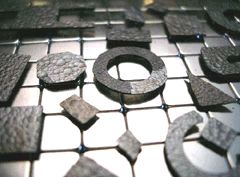
Perhaps the substance that displays the strongest diamagnetism is bismuth, used in guns. Melting down bismuth and then molding it is a very efficient way of capturing the diamagnetic properties.
A thin slice of pyrolitic graphite, (used as a lubricant and as a moderator in nuclear reactors), which is an unusually strongly diamagnetic material, can be stably floated on a magnetic field, such as that from rare earth permanent magnets. This can be done with all components at room temperature, making a visually effective demonstration of diamagnetism.
The Radboud University Nijmegen has conducted experiments where they have successfully levitated water and a live frog.
Superconductors are perfect diamagnets and when placed in an external magnetic field expel the field lines from their interiors (depending on field intensity and temperature). Superconductors also have zero electrical resistance, a consequence of their diamagnetism. Superconducting structures have been known to tear themselves apart with astonishing force in their attempt to escape an external field.
Due to the Meissner effect, a superconductor also expels magnetic fields (Ár = 0), much better than a diamagnet. Due to this (and flux pinning) the magnet is held at a fixed distance from the superconductor or vice versa.
Perhaps this clay material was pyrolitic graphite or bismuth, whose diamagnetic repelling properties were greatly magnified or even a natural room temperature superconductor!
 Consider that magnetic flux lines are spaced apart depending on their proximity to the magnet, which clearly follows an inverse square law.
That is, the further you get from the magnet, the more the flux lines spread out and the weaker is the overall effect.
Much like shining a flashlight beam into a tight circle on a wall.
Move back and the circle expands but the light appears weaker because it covers more area. So too are magnetic flux lines and their effects weakened by distance from the magnetic source.
Meaning the more flux lines (surface area) you cover with a diamagnetically doped platform, like a water glider riding on a bubble of air, not breaking the surface tension of the water, so too would your flying platform float over the surface of the earth.
And now, almost the last item which has long interested me relating to personal flight is the legend of the 'flying carpet.' Recently, claims have arisen of the apparent discovery of a lost book which tells several fascinating stories and tells how the carpets could be made to fly using the mysterious clay I mentioned above. This is the first piece of information I've read that did not derive from Scheherazades' narration in 'The Arabian Nights.'
Consider that magnetic flux lines are spaced apart depending on their proximity to the magnet, which clearly follows an inverse square law.
That is, the further you get from the magnet, the more the flux lines spread out and the weaker is the overall effect.
Much like shining a flashlight beam into a tight circle on a wall.
Move back and the circle expands but the light appears weaker because it covers more area. So too are magnetic flux lines and their effects weakened by distance from the magnetic source.
Meaning the more flux lines (surface area) you cover with a diamagnetically doped platform, like a water glider riding on a bubble of air, not breaking the surface tension of the water, so too would your flying platform float over the surface of the earth.
And now, almost the last item which has long interested me relating to personal flight is the legend of the 'flying carpet.' Recently, claims have arisen of the apparent discovery of a lost book which tells several fascinating stories and tells how the carpets could be made to fly using the mysterious clay I mentioned above. This is the first piece of information I've read that did not derive from Scheherazades' narration in 'The Arabian Nights.'
Pieces of pyrolitic graphite, cut into various shapes, hover intriguingly. In this demonstration, about 120 objects in all floated above a base of permanent magnets. A powered device that could lift an equally large number and variety of objects using active feedback would be a significant engineering challenge to design and build, whereas this simple system of passive, diamagnetic levitation is straightforward to assemble. |
 |
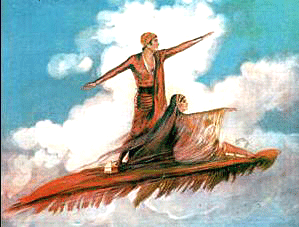 |
The Secret History of the Flying Carpet by Henri Baq |
LONG before the broomstick became popular with witches in medieval Europe, the flying carpet was being used by thieves and madmen in the Orient.
Factual evidence for what was a long-standing myth has now been found by a French explorer, Henri Baq, in Iran.
Baq has discovered scrolls of well-preserved manuscripts in underground cellars of an old Assassin castle at Alamut, near the Caspian Sea.

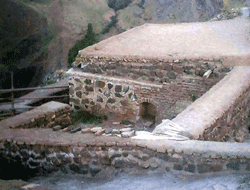
Written in the early thirteenth century by a Jewish scholar named Isaac Ben Sherira,' these manuscripts shed new light on the real story behind the flying carpet of the Arabian Nights. The discovery of these artifacts has thrown the scientific world into the most outrageous strife.
Following their translation from Persian into English by Professor G.D. Septimus, the renowned linguist, a hastily organized conference of eminent scholars from all over the world was called at the London School of Oriental and African Studies. Baq's discovery came under flak from many historians who insisted that the manuscripts were forgeries.
M. Baq, who could not attend the conference because of the birth of his child, was defended by Professor Septimus, who argued that the new findings should be properly investigated. The manuscripts are now being carbon dated at the Istituto Leonardo da Vinci, Trieste. According to Ben Sherira, Muslim rulers used to consider flying carpets as devil-inspired contraptions.
Their existence was denied, their science suppressed, their manufacturers persecuted and any evidence about incidents involving them systematically erased. Although flying carpets were woven and sold till the late thirteenth century, the clientele for them was chiefly at the fringe of respectable society.
Ben Sherira writes that flying carpets received a favorable nod from the establishment around AD 1213, when a Toranian prince demonstrated their use in attacking an enemy castle by positioning a squadron of archers on them, so as to form a kind of airborne cavalry; the art otherwise floundered, and eventually perished in the onslaught of the Mongols.
The earliest mention of the flying carpet, according to Ben Sherira's chronicle, was made in two ancient texts. The first of these is a book of proverbs collected by Shamsha-Ad, a minister of the Babylonian king Nebuchadnezzar, and the other is a book of ancient dialogues compiled by one Josephus.
None of these works survives today; however, with their aid, Ben Sherira compiled a story relating to the Queen of Sheba and King Solomon that is not found elsewhere.
Located at the southern tip of Arabia, the land of Sheba occupied the area of present-day Yemen, although some geographers claim that Ethiopia or ancient Abyssinia was also part of its territory. This country was ruled by a beautiful and powerful queen who is remembered in history as the Sheba of the Bible, the Saba or Makeda of the Ethiopian epic Kebra Negast, and the Bilqis of Islam.
At the inauguration of the queen in 977 BC, her alchemist-royal demonstrated small brown rugs that could hover a few feet above the ground.
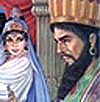 Many years later she sent a magnificent flying carpet to King Solomon.
A token of love, it was of green sendal embroidered with gold and silver and studded with precious stones, and its length and breadth were such that all the king's host could stand upon it.
The king, who was preoccupied with building his temple in Jerusalem, could not receive the gift and gave it to his courtiers. When news of this cool reception reached the queen, she was heartbroken. She dismissed her artisans and never had anything to do with flying carpets again.
Many years later she sent a magnificent flying carpet to King Solomon.
A token of love, it was of green sendal embroidered with gold and silver and studded with precious stones, and its length and breadth were such that all the king's host could stand upon it.
The king, who was preoccupied with building his temple in Jerusalem, could not receive the gift and gave it to his courtiers. When news of this cool reception reached the queen, she was heartbroken. She dismissed her artisans and never had anything to do with flying carpets again.
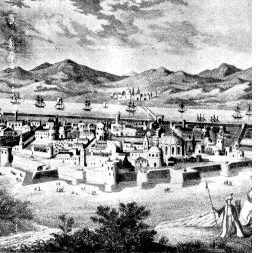 The king and the queen eventually reconciled, but the wandering artisans found no abode for many years, and eventually had to settle near the town of Baghdad in Mesopotamia in c. 934 BC.
In the Ben Sherira chronicle, certain passages describe the workings of a flying carpet. Unfortunately, much of the vocabulary used in these parts is indecipherable, so little has been understood about their method of propulsion.
What is understood is that a flying carpet was spun on a loom like an ordinary carpet; the difference lay in the dyeing process. Here, the artisans had discovered a certain clay, 'procured from mountain springs and untouched by human hand', which, when superheated at 'temperatures that exceeded those of the seventh ring of hell' in a cauldron of boiling Grecian oil, acquired anti-magnetic properties.
The king and the queen eventually reconciled, but the wandering artisans found no abode for many years, and eventually had to settle near the town of Baghdad in Mesopotamia in c. 934 BC.
In the Ben Sherira chronicle, certain passages describe the workings of a flying carpet. Unfortunately, much of the vocabulary used in these parts is indecipherable, so little has been understood about their method of propulsion.
What is understood is that a flying carpet was spun on a loom like an ordinary carpet; the difference lay in the dyeing process. Here, the artisans had discovered a certain clay, 'procured from mountain springs and untouched by human hand', which, when superheated at 'temperatures that exceeded those of the seventh ring of hell' in a cauldron of boiling Grecian oil, acquired anti-magnetic properties.
 Now the Earth itself is a magnet, and has trillions of magnetic lines crossing it from the North to the South Pole. The scientists prepared this clay and dyed the wool in it before weaving it on a loom.
So, when the carpet was finally ready, it pulled itself away from the Earth and, depending on the concentration of clay used, hovered a few feet or several hundred feet above the ground.
Propulsion went along the magnetic lines, which acted like aerial rails. Although they were known to the Druids in England and the Incas in South America, only recently are physicists beginning to rediscover the special properties of these so-called 'fey-lines'.
Now the Earth itself is a magnet, and has trillions of magnetic lines crossing it from the North to the South Pole. The scientists prepared this clay and dyed the wool in it before weaving it on a loom.
So, when the carpet was finally ready, it pulled itself away from the Earth and, depending on the concentration of clay used, hovered a few feet or several hundred feet above the ground.
Propulsion went along the magnetic lines, which acted like aerial rails. Although they were known to the Druids in England and the Incas in South America, only recently are physicists beginning to rediscover the special properties of these so-called 'fey-lines'.
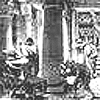 Ben Sherira writes that the great library of Alexandria, founded by Ptolemy I, kept a large stock of flying carpets for its readers. They could borrow these carpets in exchange for their slippers, to glide back and forth, up and down, among the shelves of papyrus manuscripts. The library was housed in a ziggurat that contained forty thousand scrolls of such antiquity that they had been transcribed by three hundred generations of scribes, many of whom did not understand the dead alphabet that they bore.
Ben Sherira writes that the great library of Alexandria, founded by Ptolemy I, kept a large stock of flying carpets for its readers. They could borrow these carpets in exchange for their slippers, to glide back and forth, up and down, among the shelves of papyrus manuscripts. The library was housed in a ziggurat that contained forty thousand scrolls of such antiquity that they had been transcribed by three hundred generations of scribes, many of whom did not understand the dead alphabet that they bore.
 The ceiling of this building was so high that readers often preferred to read while hovering in the air. The manuscripts were so numerous that it was said that not even a thousand men reading them day and night for fifty years could read them all. Although the library had been damaged in the civil war under the Roman emperor Aurelian, its final destruction is attributed to a Muslim general.
He burnt the papyrus to heat the six hundred baths of Alexandria, and the carpets, which frightened the wits out of his Bedouin Arabs, were thrown into the sea. Ben Sherira comments bitterly that the knowledge of Alexandria went down the drainpipe in 'washing the dirt of philistines'.
Flying carpets were discouraged in the Islamic lands for two reasons. The official line was that man was never intended to fly, and the flying carpet was a sacrilege to the order of things, an argument that was spread enthusiastically by a zealous clergy. The second reason was economic.
For the establishment, it was necessary to keep the horse and the camel as the standard means of transport. The reason was that certain Arab families, who had access to the inner chambers of successive rulers, had become rich because of their vast stud farms, where they bred hundreds of thousands of horses each year for the army, merchants and the proletariat. It was the same with camels.
Certain Egyptian king-makers (listed by Ben Sherira as the Hatimis, the Zahidis and the progeny of Abu Hanifa II) owned camel farms, and enjoyed a total monopoly on the supply of camels in the whole of the Islamic empire. None of these old families wanted their privileges usurped by a small group of poor artisans who could potentially wreck their markets by making flying carpets popular. Thus they were undermined.
Thanks to the mullahs' propaganda, the Muslim middle class was beginning to shun flying carpets by the mid-eighth century. The market for Arabian horses flourished instead. Camels were also fetching high prices.
Ben Sherira notes that a curious incident, which happened around this time, damaged the reputation of the flying carpet beyond salvation:
The ceiling of this building was so high that readers often preferred to read while hovering in the air. The manuscripts were so numerous that it was said that not even a thousand men reading them day and night for fifty years could read them all. Although the library had been damaged in the civil war under the Roman emperor Aurelian, its final destruction is attributed to a Muslim general.
He burnt the papyrus to heat the six hundred baths of Alexandria, and the carpets, which frightened the wits out of his Bedouin Arabs, were thrown into the sea. Ben Sherira comments bitterly that the knowledge of Alexandria went down the drainpipe in 'washing the dirt of philistines'.
Flying carpets were discouraged in the Islamic lands for two reasons. The official line was that man was never intended to fly, and the flying carpet was a sacrilege to the order of things, an argument that was spread enthusiastically by a zealous clergy. The second reason was economic.
For the establishment, it was necessary to keep the horse and the camel as the standard means of transport. The reason was that certain Arab families, who had access to the inner chambers of successive rulers, had become rich because of their vast stud farms, where they bred hundreds of thousands of horses each year for the army, merchants and the proletariat. It was the same with camels.
Certain Egyptian king-makers (listed by Ben Sherira as the Hatimis, the Zahidis and the progeny of Abu Hanifa II) owned camel farms, and enjoyed a total monopoly on the supply of camels in the whole of the Islamic empire. None of these old families wanted their privileges usurped by a small group of poor artisans who could potentially wreck their markets by making flying carpets popular. Thus they were undermined.
Thanks to the mullahs' propaganda, the Muslim middle class was beginning to shun flying carpets by the mid-eighth century. The market for Arabian horses flourished instead. Camels were also fetching high prices.
Ben Sherira notes that a curious incident, which happened around this time, damaged the reputation of the flying carpet beyond salvation:
 On a bright Friday afternoon in Baghdad, when the white disc of the sun blazed in the third quarter of middle heaven, and the bazaar bustled with people buying fruits and cloth and watching an auction of fair-skinned slaves, there appeared across the sun the shimmering wraith of a turbaned man gliding towards the highest minaret of the Royal Palace.
The devil was no other than a poor soldier who had once served in the palace. He had been caught holding the youngest princess's hand, and was thrown out by the eunuchs, disgraced and defeated. When news about this affair reached the caliph, he was furious.
He had the princess locked up in a tower, and to humiliate her, decided to marry her off to his royal executioner, a towering black slave from Zanzibar. The soldier, a Kurdish youth by the name of Mustafa, now returned. He glided up to the minaret and helped a girl climb out of the window. Then in full view of the public below, he glided away. The bazaaris cheered.
As the young lovers eloped on their carpet, a battery of the elite guard, mounted on black Arabian stallions, charged out of the palace and gave chase. But the flying carpet disappeared in the clouds above. The establishment retaliated by hunting down everyone even remotely involved with the business of flying carpets.
Thirty artisans were rounded up with their families in a public square. A paid audience was assembled. The men were accused of being libertines, and their heads rolled in the dust, all chopped off by the black executioner from Zanzibar.
On a bright Friday afternoon in Baghdad, when the white disc of the sun blazed in the third quarter of middle heaven, and the bazaar bustled with people buying fruits and cloth and watching an auction of fair-skinned slaves, there appeared across the sun the shimmering wraith of a turbaned man gliding towards the highest minaret of the Royal Palace.
The devil was no other than a poor soldier who had once served in the palace. He had been caught holding the youngest princess's hand, and was thrown out by the eunuchs, disgraced and defeated. When news about this affair reached the caliph, he was furious.
He had the princess locked up in a tower, and to humiliate her, decided to marry her off to his royal executioner, a towering black slave from Zanzibar. The soldier, a Kurdish youth by the name of Mustafa, now returned. He glided up to the minaret and helped a girl climb out of the window. Then in full view of the public below, he glided away. The bazaaris cheered.
As the young lovers eloped on their carpet, a battery of the elite guard, mounted on black Arabian stallions, charged out of the palace and gave chase. But the flying carpet disappeared in the clouds above. The establishment retaliated by hunting down everyone even remotely involved with the business of flying carpets.
Thirty artisans were rounded up with their families in a public square. A paid audience was assembled. The men were accused of being libertines, and their heads rolled in the dust, all chopped off by the black executioner from Zanzibar.
 Next, the caliph sent his spies to every corner of his empire ordering them to bring back every remaining flying carpet and artisan to Baghdad. The small community of artisans, who had lived near the Tigris for several centuries, packed their possessions and, with only three male survivors, fled.
After wandering for many months through the moon-like wastes of Iranian marshlands, they reached, ragged and near death, the shining city of Bukhara, where the emir, who did not take orders from Baghdad, gave them refuge.
Next, the caliph sent his spies to every corner of his empire ordering them to bring back every remaining flying carpet and artisan to Baghdad. The small community of artisans, who had lived near the Tigris for several centuries, packed their possessions and, with only three male survivors, fled.
After wandering for many months through the moon-like wastes of Iranian marshlands, they reached, ragged and near death, the shining city of Bukhara, where the emir, who did not take orders from Baghdad, gave them refuge.
This exodus, Isaac notes, happened in AD 776, a decade before the celebrated reign of Harun ur Rashid, when The Thousand and One Nights was written. Isaac believes that the inspiration for at least one of the tales in the Arabian Nights comes from the incident of the eloping lovers on that bright Friday afternoon in Baghdad.
Ben Sherira describes the genealogy of the artisans in great detail. Some of these families later migrated to Afghanistan and established themselves in the Kingdom of Ghor. The most renowned family of carpet weavers, the Halevis, settled in the town of Merv, where they began to introduce patterns into their carpets.
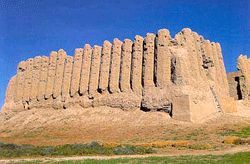
The ruins of the oasis-city of Merv (Mary) in Turkmenistan lie on the millenary Silk Route in Central Asia and embody 4,000 years of the history of human settlement in this desert region.
This building at Merv is known as the Great Kiz Kala. It was built in the 6th century, long before Sultan Sanjar used it as his palace.
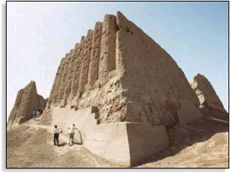
The mandala in the centre was a trademark of the master, Jacob Yahud Halevi ? the same Jacob who appears in history as the teacher of Avicenna. Artisans also wandered (or flew) into Europe, where their recipes were subsequently employed by a feminist secret society, that of the witches.
Their persecution, meted out by the church, was equally swift. Ben Sherira claims that the witches' trademark, the broomstick, with its phallic symbolism, was developed because of their lack of male company.
In Transoxiana, the flying carpet enjoyed a brief renaissance before being erased forever by the Mongol hordes of Genghis Khan.
Transoxiana (sometimes spelled Transoxania) is the largely obsolete name used for the portion of Central Asia corresponding approximately with modern-day Uzbekistan and southwest Kazakhstan. Geographically, it means the region between the Amu Darya and Syr Darya rivers. When used in the present, it usually implies that one is talking about that region in the time prior to about the 8th century CE, although the term continued to remain in use among western historians for several centuries later. The name is Latin and means, 'beyond the Oxus River.'
Two incidents are worthy of mention here. In 1213, Prince Behroz of the state of Khorasan in eastern Persia, took to heart a young Jewess, Ashirah. Her father was an accomplished carpet-maker. Behroz married Ashirah against the wishes of his family, and requested his father-in-law to weave two dozen flying carpets using the best wool and the best clay, specially wound on a bamboo frame to make them more robust.
Next he had forty-eight of his handpicked archers trained by a Japanese master by the name of Ryu Taro Koike (1153-1240?). When the archers were ready and the carpets delivered, he assembled his men and gave each man his weapons: twenty steel-pointed arrows tipped with rattlesnake venom, longbows made of layers of deodar and catgut, and Armenian daggers.
Two men were assigned to each carpet: one fore, one aft. Some carried fireballs. Behroz thus conceived four squadrons of the first airborne cavalry of the world, which went into action when his father waged a war against the neighboring Khwarzem Shah. The archers led the assault: they attacked the castle, dived in and flew out, felled the defenders and threw fireballs inside its compound, setting it ablaze.
The Toranian military brass were awed. They sensed that the prince could become a threat to their oligarchy, and with his father's consent, blinded him. The prince's wife, heavy with child, and her ailing father were banished from the kingdom.
Around this time, the Abbasids no longer wielded the same power as in the days of Harun ur Rashid. Many local kings and emirs were taking matters into their own hands. As the grip of the empire on its states weakened, a cult of the flying carpet flourished. Young dissidents, political refugees, hermits and agnostics went airborne for their escapades. Merchants also began to see the advantages of the flying carpet.
The flying carpet was not only a much speedier form of transport than the camel but also a safer one since bandits would not waylay a flying trade caravan ? unless they themselves were on a fleet of flying carpets. Artisans began to weave bigger carpets, but with more people on board these became sluggish and lost height.
But there is one episode, witnessed by many people on the ground, where a party of turbaned men flew from Samarkand to Isfahan at whirlwind speed. This incident is corroborated in the facsimile of another rare text, produced in the seventeenth century, in which one witness is quoted as saying 'We saw a strange whirling disc in the sky, which flew over our village [Nishapur], trailing fire and sulphur', and another: 'A band of djinn appeared over our caravan, heading towards the Straits of Ormuz.'[sup5] (The thirteenth-century original of this text is impossible to find.)
The next incident, before the terrible invasion from the steppes, was the last straw in the ill-fated history of the flying carpet. In 1223, a dragoman of Georgia arrived in Bukhara with his harem to shop for Chinese silk. Ben Sherira's source, the guardian of Minareh Kalyan, describes what eventuated:
On a pleasant evening, when the suk was bustling with people, and the veiled ladies from Georgia had just disembarked from their litters and were being escorted to the silk merchant, a madman appeared from behind a dome and swooped down at them.
The flier was a giant of a man with a magnificent black beard and long hair trailing in the wind behind him. He was wearing a loincloth, his eyes were a luminous green, an eagle was flying by his side, and he was laughing madly.
The women saw this apparition heading towards them and froze with terror as he tore away his loincloth and started urinating in their upturned faces. This man was the mathematician-royal of Samarkand, Karim Beg Isfahani. Betrayed by his Georgian mistress, he had drunk a goblet of fermented grapes and gone insane.
The incident caused pandemonium. A spear was launched that caught him in the chest, and he fell, dead, into a palm tree. But the outrage caused in Bukhara was understandable.
Fearing another massacre, the artisans burnt their laboratories, left their possessions, and fled in all directions. Ben Sherira writes that on that fateful day they swore never again to weave together a flying carpet.
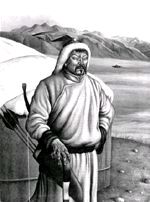 The story almost ends here. In 1226 Genghis Khan laid waste most of the cities in Central Asia. Their inhabitants were massacred; their treasures plundered. The towers of skulls outside Herat, Balkh and Bukhara ? so vast that the whole countryside reeked with their stench ? included the skulls of the artisans.
In their loot, the Mongols found flying carpets. When a prisoner told them that these contraptions were more agile than the steppes pony (a blasphemy to Mongol ears, if ever there was one), the great Khan beheaded him and had his skull made into a drinking mug. He ordered all flying carpets in his vast empire confiscated.
The story almost ends here. In 1226 Genghis Khan laid waste most of the cities in Central Asia. Their inhabitants were massacred; their treasures plundered. The towers of skulls outside Herat, Balkh and Bukhara ? so vast that the whole countryside reeked with their stench ? included the skulls of the artisans.
In their loot, the Mongols found flying carpets. When a prisoner told them that these contraptions were more agile than the steppes pony (a blasphemy to Mongol ears, if ever there was one), the great Khan beheaded him and had his skull made into a drinking mug. He ordered all flying carpets in his vast empire confiscated.

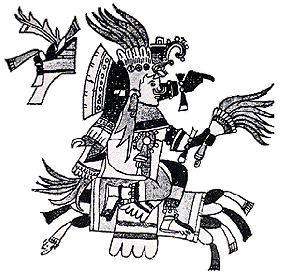
Aztec god Homoyoca
flying on 'Magic Carpet'
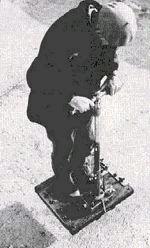
Grebennikov taking off on his levitating platform
I must tell you I removed the background scribbles and the mouth mask from the image of the god which I now realize was attached to the fan shape behind his head to give him directional control.
The image reminds me of how I speculated a flying carpets HEIGHT could be controlled in Arabian Flying Carpets by rolling it up to cross less flux lines, thus lessening the repulsion from the earth. As well, there is a correlation to Grebennikovs' platform that used insect wings to deflect local gravity and allow flight.
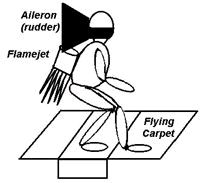 Please note on the Gods back, a golf bag looking thing with what could be flames shooting out the bottom, as would be the case with a jetpack.
In the event the carpet was doped with the special clay wielding dye described as used to fabricate flying carpets, it would only provide LIFT, whereas a jetpack would provide thrust in the preferred direction.
Please note on the Gods back, a golf bag looking thing with what could be flames shooting out the bottom, as would be the case with a jetpack.
In the event the carpet was doped with the special clay wielding dye described as used to fabricate flying carpets, it would only provide LIFT, whereas a jetpack would provide thrust in the preferred direction.
 On reading this a few days later, I realize the fan blade at the back of the gods head was attached by a black strap to the lower part of his face, meaning at high speed, he could turn his head which would act as a rudder or aileron to deflect air and allow the flying carpet to be TURNED! I would also think there would be a strap to hold the flyer onto the carpet. Shades of 'the Rocketeer!'
According to the preceding Flying Carpet story, the Earths' lines of magnetic force are in motion, thus providing 'aerial rails'.
Meaning you could fly your carpet into the path of one of these lines and be caught up in the flow as a means of propulsion. There are many UFO reports stating they use magnetic lines of force for propulsion and for lift.
Yet another possible clue to all this is in this Ship of Heaven article.
On reading this a few days later, I realize the fan blade at the back of the gods head was attached by a black strap to the lower part of his face, meaning at high speed, he could turn his head which would act as a rudder or aileron to deflect air and allow the flying carpet to be TURNED! I would also think there would be a strap to hold the flyer onto the carpet. Shades of 'the Rocketeer!'
According to the preceding Flying Carpet story, the Earths' lines of magnetic force are in motion, thus providing 'aerial rails'.
Meaning you could fly your carpet into the path of one of these lines and be caught up in the flow as a means of propulsion. There are many UFO reports stating they use magnetic lines of force for propulsion and for lift.
Yet another possible clue to all this is in this Ship of Heaven article.
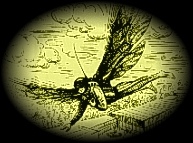 All fantasy and misdirection or could there be something to it? I happen to think we can in fact deflect aether/zpe to reduce or even cancel local gravity. In time, in time...
In Mexico, they call jigsaw puzzles rompe cabeza (head breakers)....pieces of our puzzles come through every day, whether from lost, new, rediscovered facts, anecdotes or new views from many people.
KeelyNet continues to post what is shared with us as well as what we find in hopes of one day being able to see these novel technologies in practical use.
All fantasy and misdirection or could there be something to it? I happen to think we can in fact deflect aether/zpe to reduce or even cancel local gravity. In time, in time...
In Mexico, they call jigsaw puzzles rompe cabeza (head breakers)....pieces of our puzzles come through every day, whether from lost, new, rediscovered facts, anecdotes or new views from many people.
KeelyNet continues to post what is shared with us as well as what we find in hopes of one day being able to see these novel technologies in practical use.
Your financial support is much appreciated!

Search for similar information

Search the KeelyNet list archive
Return to KeelyNet

Find something
useful or
interesting?
Donations Appreciated!



KeelyNet
Products
Mexistim
NEXUS article on
the Crock Machine
and the MexiStim
Polarity Cycler
reported to boost
energy levels!
KeelyNet Teeshirts
$14.95
Setup your own electric generating systems
BlastIT Rife
Research Handbook
746 page, 5 pound
detailed book
High Voltage
& Free Energy Devices
experimenters handbook, covers low and high voltage as well as hydrogen generation projects
Book & Video
catalog
our assortment of books and videos we sell to help support KeelyNet - we take Visa/MC credit cards, PayPal or money orders, thanks!
 |
 |
 On a bright Friday afternoon in Baghdad, when the white disc of the sun blazed in the third quarter of middle heaven, and the bazaar bustled with people buying fruits and cloth and watching an auction of fair-skinned slaves, there appeared across the sun the shimmering wraith of a turbaned man gliding towards the highest minaret of the Royal Palace.
The devil was no other than a poor soldier who had once served in the palace. He had been caught holding the youngest princess's hand, and was thrown out by the eunuchs, disgraced and defeated. When news about this affair reached the caliph, he was furious.
He had the princess locked up in a tower, and to humiliate her, decided to marry her off to his royal executioner, a towering black slave from Zanzibar. The soldier, a Kurdish youth by the name of Mustafa, now returned. He glided up to the minaret and helped a girl climb out of the window. Then in full view of the public below, he glided away. The bazaaris cheered.
As the young lovers eloped on their carpet, a battery of the elite guard, mounted on black Arabian stallions, charged out of the palace and gave chase. But the flying carpet disappeared in the clouds above. The establishment retaliated by hunting down everyone even remotely involved with the business of flying carpets.
Thirty artisans were rounded up with their families in a public square. A paid audience was assembled. The men were accused of being libertines, and their heads rolled in the dust, all chopped off by the black executioner from Zanzibar.
On a bright Friday afternoon in Baghdad, when the white disc of the sun blazed in the third quarter of middle heaven, and the bazaar bustled with people buying fruits and cloth and watching an auction of fair-skinned slaves, there appeared across the sun the shimmering wraith of a turbaned man gliding towards the highest minaret of the Royal Palace.
The devil was no other than a poor soldier who had once served in the palace. He had been caught holding the youngest princess's hand, and was thrown out by the eunuchs, disgraced and defeated. When news about this affair reached the caliph, he was furious.
He had the princess locked up in a tower, and to humiliate her, decided to marry her off to his royal executioner, a towering black slave from Zanzibar. The soldier, a Kurdish youth by the name of Mustafa, now returned. He glided up to the minaret and helped a girl climb out of the window. Then in full view of the public below, he glided away. The bazaaris cheered.
As the young lovers eloped on their carpet, a battery of the elite guard, mounted on black Arabian stallions, charged out of the palace and gave chase. But the flying carpet disappeared in the clouds above. The establishment retaliated by hunting down everyone even remotely involved with the business of flying carpets.
Thirty artisans were rounded up with their families in a public square. A paid audience was assembled. The men were accused of being libertines, and their heads rolled in the dust, all chopped off by the black executioner from Zanzibar.
 Next, the caliph sent his spies to every corner of his empire ordering them to bring back every remaining flying carpet and artisan to Baghdad. The small community of artisans, who had lived near the Tigris for several centuries, packed their possessions and, with only three male survivors, fled.
After wandering for many months through the moon-like wastes of Iranian marshlands, they reached, ragged and near death, the shining city of Bukhara, where the emir, who did not take orders from Baghdad, gave them refuge.
Next, the caliph sent his spies to every corner of his empire ordering them to bring back every remaining flying carpet and artisan to Baghdad. The small community of artisans, who had lived near the Tigris for several centuries, packed their possessions and, with only three male survivors, fled.
After wandering for many months through the moon-like wastes of Iranian marshlands, they reached, ragged and near death, the shining city of Bukhara, where the emir, who did not take orders from Baghdad, gave them refuge.
 |
The ruins of the oasis-city of Merv (Mary) in Turkmenistan lie on the millenary Silk Route in Central Asia and embody 4,000 years of the history of human settlement in this desert region. |
This building at Merv is known as the Great Kiz Kala. It was built in the 6th century, long before Sultan Sanjar used it as his palace. |
 |
 The story almost ends here. In 1226 Genghis Khan laid waste most of the cities in Central Asia. Their inhabitants were massacred; their treasures plundered. The towers of skulls outside Herat, Balkh and Bukhara ? so vast that the whole countryside reeked with their stench ? included the skulls of the artisans.
In their loot, the Mongols found flying carpets. When a prisoner told them that these contraptions were more agile than the steppes pony (a blasphemy to Mongol ears, if ever there was one), the great Khan beheaded him and had his skull made into a drinking mug. He ordered all flying carpets in his vast empire confiscated.
The story almost ends here. In 1226 Genghis Khan laid waste most of the cities in Central Asia. Their inhabitants were massacred; their treasures plundered. The towers of skulls outside Herat, Balkh and Bukhara ? so vast that the whole countryside reeked with their stench ? included the skulls of the artisans.
In their loot, the Mongols found flying carpets. When a prisoner told them that these contraptions were more agile than the steppes pony (a blasphemy to Mongol ears, if ever there was one), the great Khan beheaded him and had his skull made into a drinking mug. He ordered all flying carpets in his vast empire confiscated.

|
|
 Please note on the Gods back, a golf bag looking thing with what could be flames shooting out the bottom, as would be the case with a jetpack.
In the event the carpet was doped with the special clay wielding dye described as used to fabricate flying carpets, it would only provide LIFT, whereas a jetpack would provide thrust in the preferred direction.
Please note on the Gods back, a golf bag looking thing with what could be flames shooting out the bottom, as would be the case with a jetpack.
In the event the carpet was doped with the special clay wielding dye described as used to fabricate flying carpets, it would only provide LIFT, whereas a jetpack would provide thrust in the preferred direction.
 On reading this a few days later, I realize the fan blade at the back of the gods head was attached by a black strap to the lower part of his face, meaning at high speed, he could turn his head which would act as a rudder or aileron to deflect air and allow the flying carpet to be TURNED! I would also think there would be a strap to hold the flyer onto the carpet. Shades of 'the Rocketeer!'
According to the preceding Flying Carpet story, the Earths' lines of magnetic force are in motion, thus providing 'aerial rails'.
Meaning you could fly your carpet into the path of one of these lines and be caught up in the flow as a means of propulsion. There are many UFO reports stating they use magnetic lines of force for propulsion and for lift.
Yet another possible clue to all this is in this Ship of Heaven article.
On reading this a few days later, I realize the fan blade at the back of the gods head was attached by a black strap to the lower part of his face, meaning at high speed, he could turn his head which would act as a rudder or aileron to deflect air and allow the flying carpet to be TURNED! I would also think there would be a strap to hold the flyer onto the carpet. Shades of 'the Rocketeer!'
According to the preceding Flying Carpet story, the Earths' lines of magnetic force are in motion, thus providing 'aerial rails'.
Meaning you could fly your carpet into the path of one of these lines and be caught up in the flow as a means of propulsion. There are many UFO reports stating they use magnetic lines of force for propulsion and for lift.
Yet another possible clue to all this is in this Ship of Heaven article.
 All fantasy and misdirection or could there be something to it? I happen to think we can in fact deflect aether/zpe to reduce or even cancel local gravity. In time, in time...
In Mexico, they call jigsaw puzzles rompe cabeza (head breakers)....pieces of our puzzles come through every day, whether from lost, new, rediscovered facts, anecdotes or new views from many people.
KeelyNet continues to post what is shared with us as well as what we find in hopes of one day being able to see these novel technologies in practical use.
All fantasy and misdirection or could there be something to it? I happen to think we can in fact deflect aether/zpe to reduce or even cancel local gravity. In time, in time...
In Mexico, they call jigsaw puzzles rompe cabeza (head breakers)....pieces of our puzzles come through every day, whether from lost, new, rediscovered facts, anecdotes or new views from many people.
KeelyNet continues to post what is shared with us as well as what we find in hopes of one day being able to see these novel technologies in practical use.

 |
|
| Search the KeelyNet list archive |
Return to KeelyNet |

useful or interesting? Donations Appreciated!   
|
Products NEXUS article on the Crock Machine and the MexiStim Polarity Cycler reported to boost energy levels! |
KeelyNet Teeshirts $14.95 |
Setup your own electric generating systems |
BlastIT Rife Research Handbook 746 page, 5 pound detailed book |
High Voltage & Free Energy Devices experimenters handbook, covers low and high voltage as well as hydrogen generation projects |
Book & Video catalog our assortment of books and videos we sell to help support KeelyNet - we take Visa/MC credit cards, PayPal or money orders, thanks! |
 It made me recall a story told to me by Dan Davidson when he was consulting for an island military base. They lived on a small nearby island which had an asphalt road circling the island next to the beach. Dan said his wife and her friend would bike or jog on this asphalt road around the island for exercise.
One day, they stopped for a rest and noticed something 'glinting' in the sky. On closer inspection it was a man dressed in a silver suit, noiselessly hovering over the island. He was looking in towards the island and doing a slow spin as if inspecting or filming it.
This flying man paid no attention to the women below who were of course amazed at what they were seeing. Though he was hovering over land, there were no air blasts from his direction nor was there any sound.
Eventually, after he had surveyed the island from his fixed hovering location, he did a slow spin around to face out to the ocean, then moved out over the ocean, picking up speed until he disappeared from sight.
It made me recall a story told to me by Dan Davidson when he was consulting for an island military base. They lived on a small nearby island which had an asphalt road circling the island next to the beach. Dan said his wife and her friend would bike or jog on this asphalt road around the island for exercise.
One day, they stopped for a rest and noticed something 'glinting' in the sky. On closer inspection it was a man dressed in a silver suit, noiselessly hovering over the island. He was looking in towards the island and doing a slow spin as if inspecting or filming it.
This flying man paid no attention to the women below who were of course amazed at what they were seeing. Though he was hovering over land, there were no air blasts from his direction nor was there any sound.
Eventually, after he had surveyed the island from his fixed hovering location, he did a slow spin around to face out to the ocean, then moved out over the ocean, picking up speed until he disappeared from sight.